A healthy meal plan is a scientifically designed eating strategy that focuses on wholesome, nutrient-rich, and low-calorie foods. Adhering to such a plan offers numerous benefits, especially for weight management and overall health improvement. So, how can you create a quick and effective 1-week healthy meal plan? Let’s explore the details with Kamereo below!
Suggested 1-Week Healthy Meal Plan
Based on the principles of healthy eating, which prioritize fresh, clean ingredients, adequate protein, fiber, and good carbohydrates, you can consider the following 7-day healthy meal plan for weight loss:
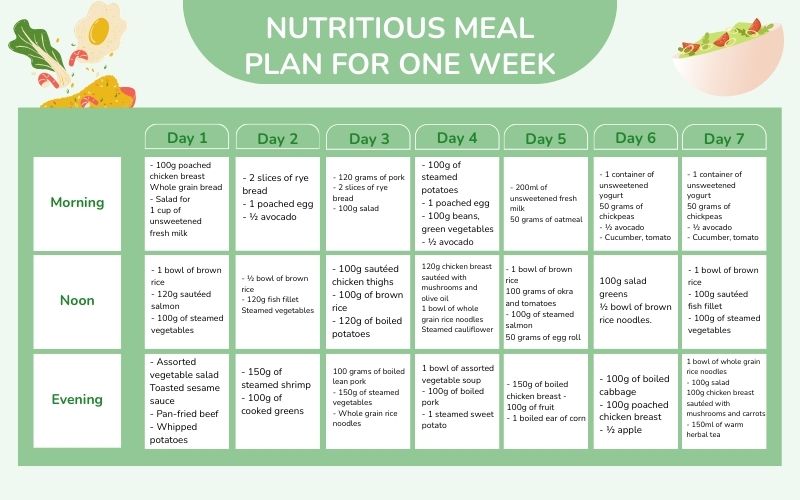
Day 1
- Breakfast (approx. 405 calories): 100g boiled chicken breast, whole-grain bread, vegetable salad, and 1 glass of unsweetened fresh milk.
- Lunch (approx. 505 calories): 1 bowl of brown rice, 120g pan-seared salmon, 100g boiled vegetables.
- Dinner (approx. 408 calories): Mixed vegetable salad, roasted sesame dressing, pan-seared beef, mashed potatoes.
Day 2
- Breakfast (approx. 350 calories): 2 slices of rye bread, 1 boiled egg, ½ avocado.
- Lunch (approx. 290 calories): ½ bowl of brown rice, 120g fish fillet, steamed vegetables.
- Dinner (approx. 190 calories): 150g steamed shrimp, 100g boiled cabbage.
Day 3
- Breakfast (approx. 500 calories): 120g pork, 2 slices of rye bread, 100g salad.
- Lunch (approx. 430 calories): 100g pan-seared chicken thigh, 100g brown rice, 120g boiled potatoes.
- Dinner (approx. 497 calories): 100g boiled lean pork, 150g boiled vegetables, brown rice vermicelli.
Day 4
- Breakfast (approx. 450 calories): 100g steamed sweet potato, 1 boiled egg, 100g beans, green vegetables, ½ avocado.
- Lunch (approx. 475 calories): 120g chicken breast stir-fried with mushrooms in olive oil, 1 bowl of brown rice noodles, boiled cauliflower.
- Dinner (approx. 200 calories): 1 bowl of mixed vegetable soup, 100g boiled pork, 1 boiled sweet potato.
Day 5
- Breakfast (approx. 260 calories): 200ml unsweetened fresh milk, 50g oats.
- Lunch (approx. 565 calories): 1 bowl of brown rice, 100g okra and tomatoes, 100g steamed salmon, 50g egg rolls.
- Dinner (approx. 430 calories): 150g boiled chicken breast, 100g fruit, 1 boiled corn on the cob.
Day 6
- Breakfast (approx. 315 calories): 1 container of unsweetened yogurt, 50g chickpeas, ½ avocado, cucumber, tomato.
- Lunch (approx. 140 calories): 100g vegetable salad, ½ bowl of brown rice vermicelli.
- Dinner (approx. 240 calories): 100g boiled napa cabbage, 100g boiled chicken breast, ½ apple.
Day 7
- Breakfast (approx. 255 calories): 2 slices of rye bread, 1 fried egg, 150ml warm lemon water.
- Lunch (approx. 465 calories): 1 bowl of brown rice, 100g pan-seared fish fillet, 100g boiled vegetables.
- Dinner (approx. 440 calories): 1 bowl of brown rice vermicelli, 100g salad, 100g chicken breast stir-fried with mushrooms and carrots, 150ml warm herbal tea.
Principles for Building a Healthy Meal Plan
General Principles
To build a healthy and balanced diet, you need to adhere to the following general principles to ensure adequate nutrition, support health, and form good habits:
- Energy: Each meal should provide approximately 300 – 500 kcal.
- Carbohydrates: Prioritize whole-grain and fiber-rich carbohydrate sources such as brown rice, whole-wheat bread, and various tubers.
- Protein: Ensure sufficient protein intake, prioritizing white proteins (poultry, fish, legumes) and limiting red meat (beef, pork, lamb) to under 500g per week.
Fats: Include enough fats, especially beneficial unsaturated fats from fatty fish, nuts, and avocados. - Meal Frequency: Divide your food intake into multiple smaller meals throughout the day, with 3 – 4 hours between each meal.
- Dinner Time: It’s best to eat dinner at least 3 hours before bedtime to aid digestion and effectively manage weight.
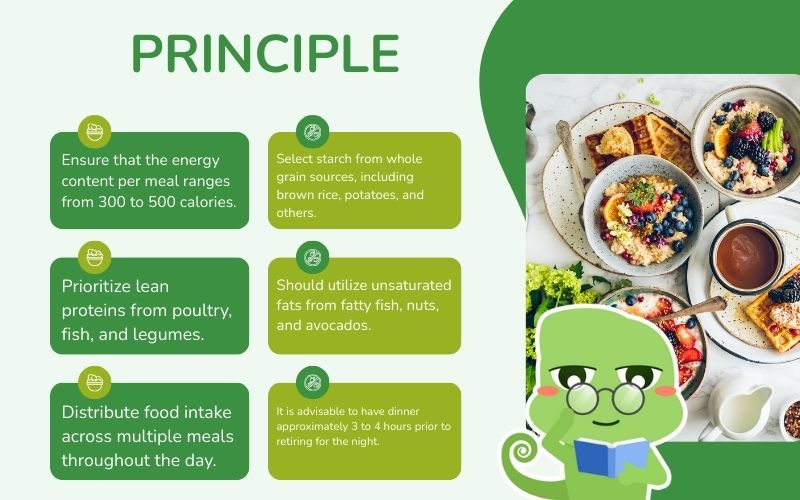
Healthy Breakfast Foods
Breakfast is a crucial start to the day, providing essential energy and nutrients after a long sleep. To ensure a productive day of work and study, selecting breakfast foods should be prioritized, focusing on the following food groups:
- Protein Sources:
- Eggs (boiled, fried, sunny-side up)
- Milk and dairy products (yogurt, cheese)
- Legumes and nuts (almonds, walnuts, chia seeds)
- Lean meats (chicken, beef)
- Protein shakes
- Fiber Sources:
- Whole-grain toast
- Oats
- Green vegetables (broccoli, spinach)
- Fruits (apples, bananas, strawberries)
- Healthy Fat Sources:
- Avocado
- Nuts
- Various fruits and vegetables
- Green tea
If you’re too busy to prepare breakfast, fresh fruit is a quick and convenient option to supplement vitamins, minerals, and some energy for your body. Additionally, try to build a balanced breakfast, including at least one protein source, one fiber source, and one fruit or vegetable.
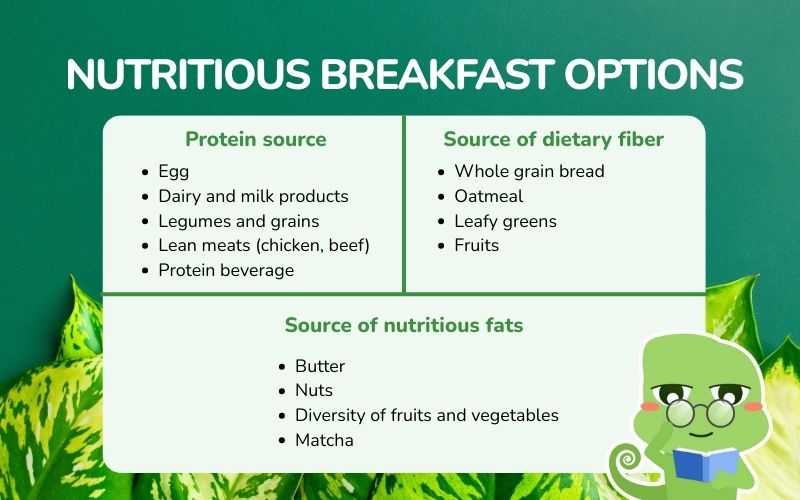
Healthy Lunch Foods
Depending on your preferences and diet, you can flexibly choose plant-based, low-carb, keto, or paleo-style dishes for lunch. Here are some suitable healthy lunch food suggestions:
- Plant-based Foods: Rich in fiber, vitamins, and minerals, they help you feel full longer and support effective weight loss.
- Lentil soup: Provides protein, carbs, and iron, suitable for vegetarians.
- Chickpea salad sandwich with vegetables: Chickpeas support weight management and are rich in nutrients.
- Vegetarian rolls with tofu and vegetables: Easily customizable to taste, serve with dipping sauce for enhanced flavor.
- Low-carb or Keto Lunch: Focus on healthy fats and protein, limiting carbohydrates.
- Cauliflower rice: Low-carb, rich in vitamin C.
- Tuna egg salad stuffed bell peppers: Rich in protein, promotes a feeling of fullness.
- Zucchini noodles with chicken: Combines fiber and protein, aids in weight control.
- Lemon salad with chicken and quinoa: Provides protein and essential fatty acids.
- Black bean soup: Rich in fiber, good for digestion.
- Paleo Diet Lunch: Prioritizes natural foods, eliminating refined and processed ingredients.
- Scrambled eggs: Simple, easy to prepare, rich in protein.
- Greek-style meatballs: Made from lean meat, spices, and herbs.
- Chicken curry: No grains, legumes, or dairy, yet still flavorful and nutritious.
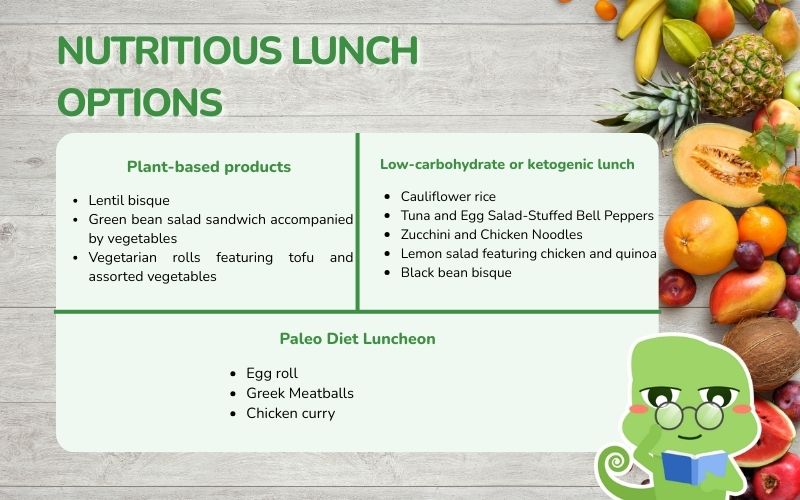
Healthy Dinner Foods
A healthy dinner not only helps your body feel lighter in the evening but also supports deep sleep and enhances overall health. Here are some healthy and easy-to-prepare dinner suggestions you can consider:
- Sweet potato salad: Combines sweet potatoes, rich in beta-carotene, vitamin C, potassium, and fiber, with greens, beans, chicken breast, or salmon to create a nutritionally balanced salad.
- Oatmeal porridge: Oats cooked with vegetables, served with protein like chicken, boiled eggs, shrimp, or salmon, helping you feel light yet full for longer.
- Oatmeal yogurt: Mix oats and yogurt, add fruits like avocado, apple, strawberries, along with a scoop of protein or nuts to increase satiety and improve digestion.
- Lentil and kale soup: A warm soup rich in fiber and iron, good for digestion and heart health.
- Salmon curry: Salmon contains omega-3 fatty acids beneficial for the brain and heart, combined with various vegetables to create a delicious and nutritious dish.
You can also flexibly change ingredients to suit your personal taste and ensure your dinner is balanced with sufficient protein, non-starchy vegetables, carbohydrates, and healthy fats.

What to Keep in Mind When Building a Healthy Meal Plan?
When starting to build a healthy eating plan, you need to remember a few notes to set up a meal plan suitable for your body:
- Reasonably Divide Meals Throughout the Day: Design separate meals for breakfast, snacks, lunch, and dinner, avoiding skipping meals or irregular eating.
- Energy-Rich Breakfast: Prioritize foods containing protein and fiber like oats, nut milk, and fruit to start the day with energy.
- Smart Snacking: Instead of starving yourself until the main meal, you should snack on yogurt, fresh fruit, seaweed, etc. to control hunger and limit overeating later.
- Choose Clean, Traceable Foods: Prioritize organic foods and limit processed foods to ensure long-term health.
- Nutritional Balance: Ensure your diet has enough protein, healthy fats, good carbohydrates, and fiber. This helps your body function effectively, reduces cravings, and supports sustainable weight loss.
- Limit Bad Fats and Sugar: Avoid repeatedly fried oils, packaged foods, sugary drinks, and high-sugar foods. These easily lead to fat accumulation and metabolic disorders.
- Control Overall Calorie Intake: The total kcal/day needs to be suitable for your goals. People aiming for weight loss typically need 1,200 – 1,600 kcal/day for women and 1,600 – 2,000 kcal/day for men, depending on activity levels.
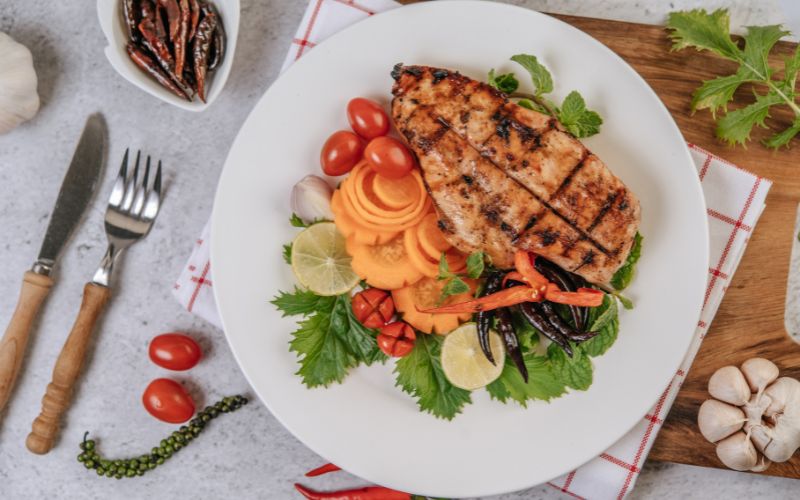
Conclusion
Through this article, you can create a 1-week healthy meal plan and build a healthy lifestyle. Maintaining a reasonable and nutritionally balanced diet for 7 days will help you effectively control weight, enhance health, and significantly improve your mood. Listen to your body, adjust your portions appropriately, prioritize fresh and clean foods, and maintain positive eating habits every day. Additionally, to expand your knowledge of health and beauty care, visit our Healthy and Beautiful section now!
See more:



